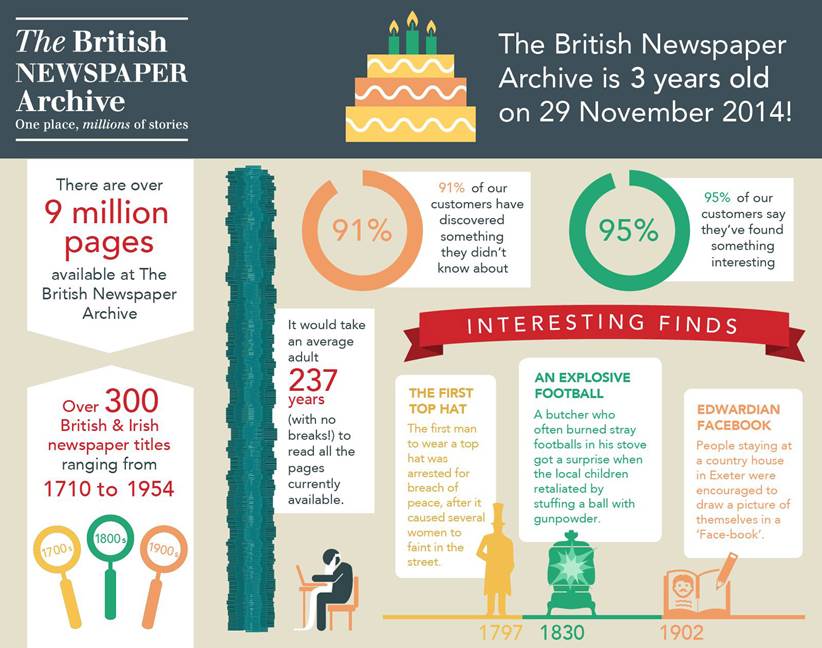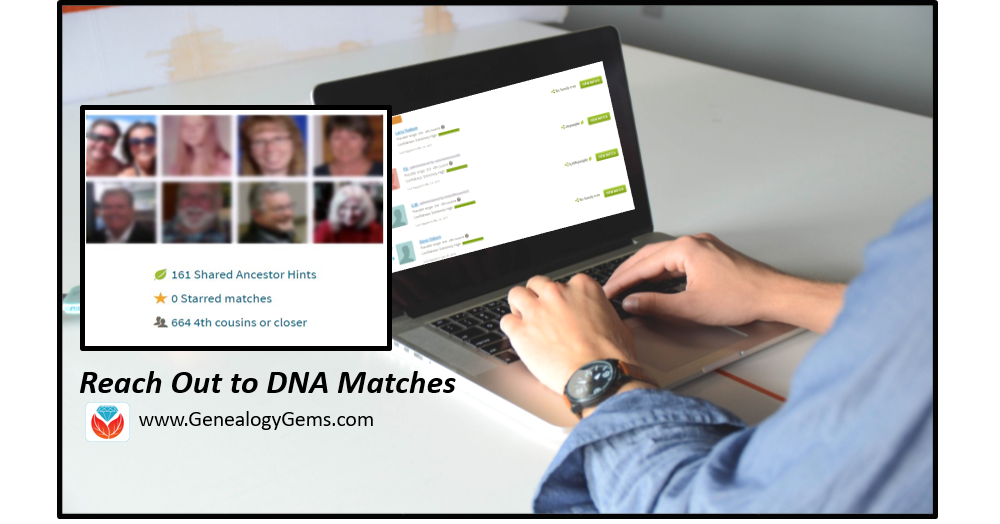by Lisa Cooke | Jan 11, 2015 | 01 What's New, British, Newspaper, Research Skills
The British Newspaper Archive celebrated its 3rd birthday recently by looking back at how people are searching its 9 million+ newspaper pages. To date, the five  most common searches are:
most common searches are:
1. Football
2. Murder
3. Death
4. Jack the Ripper
5. Railway
Not what you expected? Your digitized newspaper searches as a family historian may be a little more specific and less sports-and-murder oriented. But are they too general to yield successful results?
Here’s a tip from Lisa: “With 9 million searchable pages, the key to finding what you want is to use the Advanced Search.
 “You’ll find it under the search box. My initial search for my husband’s great grandfather resulted in tens of thousands of hits until I included mandatory keywords, his name as a phrase, a defined time frame, and zeroed in on advertisements. The 299 results were far more manageable and resulted in several fantastic finds!”
“You’ll find it under the search box. My initial search for my husband’s great grandfather resulted in tens of thousands of hits until I included mandatory keywords, his name as a phrase, a defined time frame, and zeroed in on advertisements. The 299 results were far more manageable and resulted in several fantastic finds!”
Armed with these tips, those with Irish or English roots should explore The British Newspaper Archive, even if you’ve searched there before. “We’ve come a long way since the website launched on 29 November 2011 with 4 million historic newspaper pages,” says a press release. “The collection is now more than twice the size, with over 9 million fully searchable pages available from 300 British and Irish titles. The newspapers cover 1710 – 1954, a much broader time period than at launch. If you weren’t able to find a particular person, event or place when The British Newspaper Archive launched, it’s well worth looking again now.” Visit www.britishnewspaperarchive.co.uk to try a search for free.”
Learn more about searching historical newspapers in Lisa’s book, How to Find Your Family History in Newspapers. Chapter 4 is all about the newspaper search process, and includes a copy-able Newspaper Research Worksheet.
Last of all, check out this fun infographic below from the British Newspaper Archive in honor of its birthday:

by Lisa Cooke | Apr 1, 2015 | 01 What's New, Google, History, images

” The View-Master first appeared in 1939 at the New York Worlds Fair. My View-Master Model C, pictured here, was produced between 1946 and 1955. It was made from bakelite and was the first viewer to have a slot into which the reels were placed for viewing. Believe it or not, all reels made for any view master will work in any model from 1939 to present.” Image by Jack Pearce, Flickr Creative Commons. Image used without changes; find it at https://www.flickr.com/photos/jwpearce/10725366513/.
Did you have a View-Master toy as a kid? Using these stereoscopic viewers (long before kids had cameras of their own), children could see pictures of any topic from Disney to dinosaurs to the 1958 World’s Fair in Brussels. According to a collector, whose image is posted here, “all reels made for any View-Master will work in any model from 1939 to the present.”
Well, this decades-only technology is about to get boosted into the 21st century. According to this news report, “Mattel is teaming up with Google on an upcoming virtual reality-based View-Master that is infused with Google Cardboard VR technology.”
“The Cardboard-based View-Master…will share some design elements with vintage View-Masters, but instead of dropping in a reel, you slide an Android smartphone into the unit. View-Master will work with a custom Mattel app, as well as any Google Cardboard-compatible app, of which there are now about 200 in the Google Play Store.”
Want to learn more about these great vintage toys–or share one with the next generation? Click here to purchase a View-Master Viewer and Reels and click here to purchase Collectible View-Master: An Illustrated Reference and Value Guide . (Thank you! Purchasing from these links helps support the Genealogy Gems podcast and blog.
. (Thank you! Purchasing from these links helps support the Genealogy Gems podcast and blog. )
)
 Did you know that nostalgia buffs (and anyone else) can search Google Patents for fun objects like the View-Master? Click here to see the original patent application materials for the 1939 View-Master, including a design drawing of that first model. Here’s a tip: if your ancestor ever applied for a patent, search Google Patents for his or her name! Learn more about Google Patents–and other fabulous and FREE Google tools you can use for family history–in the new, fully-revised 2nd edition of The Genealogist’s Google Toolbox by Lisa Louise Cooke.
Did you know that nostalgia buffs (and anyone else) can search Google Patents for fun objects like the View-Master? Click here to see the original patent application materials for the 1939 View-Master, including a design drawing of that first model. Here’s a tip: if your ancestor ever applied for a patent, search Google Patents for his or her name! Learn more about Google Patents–and other fabulous and FREE Google tools you can use for family history–in the new, fully-revised 2nd edition of The Genealogist’s Google Toolbox by Lisa Louise Cooke.
by Lisa Cooke | Apr 5, 2017 | 01 What's New, DNA
Trying to contact your DNA matches can be frustrating when they don’t respond, but it’s still worth reaching out to them. This researcher’s example shows a good reason why.

Contact Your DNA Matches
Recently, I heard from Genealogy Gems Premium website member Ruth*, whose DNA success story reminds me of the value of reaching out to DNA matches, even if the general response rate is low or slow. She says:
“I’ve been researching my family tree for over 20 years and sometimes it can get boring…because most of the lines are pretty much out as far as I can go and I’m now just working on brick walls! I love listening to your podcast because it motivates me to keep going!
Like many of your listeners, I have taken the autosomal DNA test. It has been an awesome tool helping me confirm family lines and sometimes finding new ones. However, I’m sure most of your readers know that for some reason a lot of those DNA matches and even tree owners in general, do not respond to emails or messages. It can be very frustrating, especially if it is one of those lines that you really could use some help on. The lack of response to inquiries sometimes makes me wonder if I should even try to make contact. Well, I want to tell your listeners, that yes it is worth it.
Recently, I was browsing trees and I came to a tree that listed my 3rd great-grandfather Daniel Cannon; however, this tree listed Daniel’s wife as Mary Ann Watkins and I had her as Mary Ann Cook! Well, I decided to contact the owner of that tree and explained I had Daniel’s wife as a Cook. The two of us started emailing back and forth and I found out this gentleman, whose last name is Watkins, had taken a DNA test and was in Ancestry.com’s database.
Sure enough, when I searched my mom’s matches I found him. Mr. Watkins shared the information he had [which was] an excerpt that listed the heirs of G. B. Watkins and Elizabeth Smith. On that list was Mary Ann Constable. From the census records, I knew that Mary Ann Cannon had married Thomas Constable after her husband had died. The marriage license for Mary Ann Cannon and Thomas Constable is no longer at the courthouse, but I was able to get a copy of the excerpt of the book it was recorded in. So now I’m climbing a whole different tree!
So, go ahead and reach out to those matches or those people who have trees with different information from you. You never know when you’ll find information and end up with a new line to research!”
Time to Maximize Your DNA Matches
 Our resident genetic genealogist, Your DNA Guide Diahan Southard, has written a series of 3 DNA quick guides to help you maximize your DNA testing experience:
Our resident genetic genealogist, Your DNA Guide Diahan Southard, has written a series of 3 DNA quick guides to help you maximize your DNA testing experience:
This “value pack” can help you sort your matches more wisely, reach out to them in a positive way, and track your correspondence. Click here to read more about these guides and order your own. (Also available as digital downloads.)
Time to Test Your DNA Today
These companies all provide autosomal DNA testing, the most popular kind of DNA testing, and the kind Ruth used. Autosomal testing matches you to genetic relatives on both sides of your family tree to a depth of about 4-6 generations. Learn a little about each by clicking on the names below.
Ancestry DNA
MyHeritage DNA
23andMe
FamilyTreeDNA
*Ruth’s letter was erroneously attributed to Liz when it was shared and discussed in Genealogy Gems Podcast episode 200. Sorry for the mix-up!
 most common searches are:
most common searches are: “You’ll find it under the search box. My initial search for my husband’s great grandfather resulted in tens of thousands of hits until I included mandatory keywords, his name as a phrase, a defined time frame, and zeroed in on advertisements. The 299 results were far more manageable and resulted in several fantastic finds!”
“You’ll find it under the search box. My initial search for my husband’s great grandfather resulted in tens of thousands of hits until I included mandatory keywords, his name as a phrase, a defined time frame, and zeroed in on advertisements. The 299 results were far more manageable and resulted in several fantastic finds!”


 Did you know that nostalgia buffs (and anyone else) can search Google Patents for fun objects like the View-Master?
Did you know that nostalgia buffs (and anyone else) can search Google Patents for fun objects like the View-Master? 
